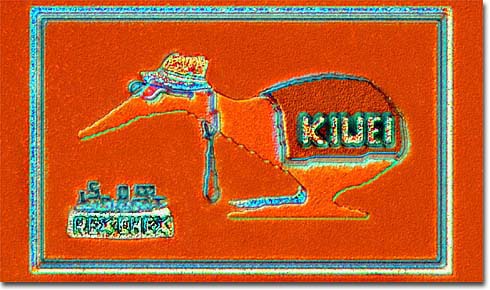Digital Kiwei
|
While scanning a math coprocessor integrated circuit from the Digital Equipment Rigel chipset, we stumbled across this silicon rendition of a New Zealand kiwi wearing sunglasses, a hat, and a necktie. The doodle is located within the pad ring and is accompanied by bowl containing the text: "rex chex". Engineer Beth Cooper, who worked on the chip design (her first) just after graduating from college, has provided some interesting background information about the doodle. The code name for the chip was actually Kiwei, which was short for "Kill Weitek". Weitek was a competing semiconductor company that specialized in math co-processors, and produced some of the best floating-point processors during the period. Originally the logo was simply a kiwi bird, but to avoid any copyright infringement on the popular shoe polish logo, the bird was disguised by adding the hat, tie, and dark sunglasses. The bowl of rex chex symbolizes the code name (Rex) for the companion microprocessor of the Rigel chipset, which contains the Sport Model Tyrannosaurus Rex doodle (also corralled in the Silicon Zoo). Rivalry between the Rex and Kiwei design teams led to the bowl of rex chex. The bowl is full of numbers, and the kiwi is symbolically eating up the numbers supplied by the Rex microprocessor, implying that the Kiwei chip could process (or "eat up") numbers far faster than Rex could provide them. Beth also mentions that the floating-point coprocessor that followed the Kiwei has a very elaborate kiwi bird, wearing a Hawaiian shirt and positioned on a windsurfing board. Apparently, because the chip die was pad-limited, there was plenty of silicon real estate for the larger logo. This chip is also the one that contains the Space Invader artwork in the scribe lane. Kiwis are native to New Zealand's forests, but they also live in scrubs, bushes and grasslands. The bird is a semi-nocturnal, flight-less avian that is seldom seen in the wild. Lacking a tail and having only two-inch (practically useless) wings, kiwis grow to about the size of a chicken and weigh between 4 and 10 pounds. Their long and slender bills have nostrils at the lower ends that are used to smell out worms, insects, and grubs. In addition to the high-protein insect and worm diet, kiwis also supplement their intake with vegetables and fruits, when available. |
© 1995-2025 by Michael W. Davidson and The Florida State University. All Rights Reserved. No images, graphics, software, scripts, or applets may be reproduced or used in any manner without permission from the copyright holders. Use of this website means you agree to all of the Legal Terms and Conditions set forth by the owners.
This website is maintained by our
|
